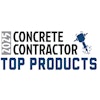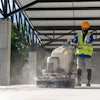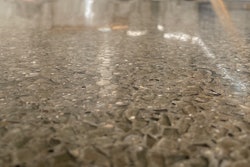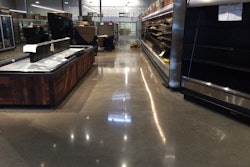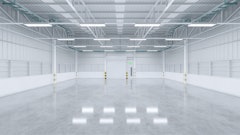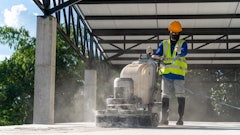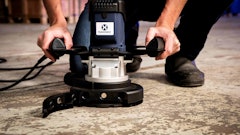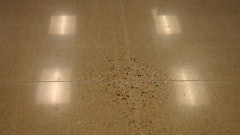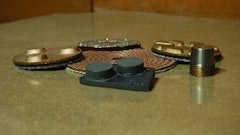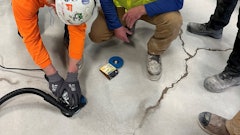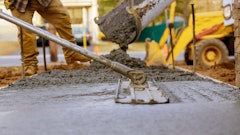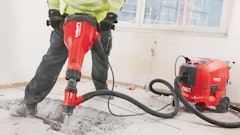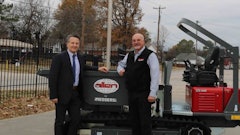Basic Housekeeping
There are some basic housekeeping procedures that are universally applicable to polished concrete floors, from highly refined small residential floors to enormous industrial floors left at a honed refinement level. Implementing these procedures is a great start and will go a long way to increasing floor longevity and long-term customer satisfaction.
Walk-off Matting / Grating
Installing walk off mats or similar, such as grating, in the entry points of a building will reduce the amount of outside debris that is tracked inside onto the polished concrete floor. This is especially important in cold weather climates where de-icing salts are used in the winter, as it will minimize the quantity of salt that is tracked onto the floor and that can cause extreme deleterious effect on concrete. Be aware that textile walk-off mats have to be regularly cleaned, as once they are saturated with debris, they no longer function efficiently.
Timely Spill Clean Up
Any liquid spilled on polished concrete should be cleaned up as soon as possible to reduce the opportunity the spilled substance has to penetrate into the concrete and, if the spill is a reactive substance, to reduce the duration of chemical attack on the floor. In addition, rapid cleanup of liquid puddles reduces the possibility of slip-fall accidents.
Dust Mopping
Frequent dust mopping removes dust and debris from the floor, reducing the amount of surface abrasion wear, as well as helping to keep a safe coefficient of friction.
Scrubbing / Mopping
Regular cleaning of the floor keeps the surface of the substrate free from soil, dirt and grime. Ideally, this would be done with an automatic scrubber, outfitted with pads specifically designed for maintaining the floor as installed. It is inadvisable to use overly aggressive scrubbing pads or stiff bristle brushes for regular cleaning on polished concrete, as these will increase the abrasion wear on the floor. In situations where the regular use of an automatic scrubber is not possible, the regular use of a wet mop is recommended. Whether using a scrubber or a mop and bucket method for cleaning the floor, best practice is to use a cleaner that is specifically designed for polished concrete, ideally one that is designed to work with the specific stain protection product that was applied at installation. This is recommended because even though a standard neutral cleaner is preferable to a cleaner that is either acidic or basic, those generic neutral cleaners often contain glycols and other additives that can harm the floor, specifically any stain protection products present in the floor.
Areas of Concern & How to Address Them
Polished concrete has three main areas of concern in terms of long-term use and maintenance: it is abradable, it is porous and it is reactive. Addressing each of these concerns in both the installation phase and the maintenance phase, using both preventative and remediative methods and procedures, will greatly enhance the aesthetic and functional life of a polished concrete floor and the owner's long-term satisfaction.
Concrete is Abradable
The surface of polished concrete is susceptible to erosion and wear caused by friction from traffic, both foot and wheeled. The typical grit equivalency of such traffic is roughly 200 grit, meaning that over time and with enough traffic, a floor that has been refined to a high level will eventually degrade to that level. The harder the surface of the floor, the more resistant it will be to this gradual degradation.
How to Address Abradability
During Installation: The application of a densifier during installation will make the surface of the concrete harder and more wear-resistant than it was prior to application. To get the full effect, densify to rejection (the concrete will not accept any further application of densifier) and use a high quality densifier. Optionally, a guard can be applied and the film formed by the topical aspect inherent in those products will act as a sacrificial wear layer, taking the abuse of traffic and being worn away, sacrificing itself to protect the underlying concrete. Be aware that the guard will need periodic reapplication and will scratch and scuff, requiring periodic burnishing to stay at a high aesthetic level.
During On-going Maintenance: If a guard type product is applied to the floor, then it acts as a sacrificial wear layer, as described above. As the acrylic polymers in most guards are relatively soft, it is easy to remediate the scratches and scuffs that occur from regular traffic by buffing or burnishing. A periodic reapplication of guard will be necessary to replace the material being abraded away or “walked off”; the frequency of this reapplication will depend on the traffic levels of the floor. If this sacrificial layer is allowed to wear away without being replaced, the surface of the concrete will be exposed and subject to the same wear profile as an un-guarded floor and if this situation persists long enough, the concrete surface will have to be repolished / re-refined with abrasives to restore its aesthetic levels.
If no guard is applied and the surface is either treated with a penetrating stain protector or not stain protected, then the surface of the polished concrete will be subject to erosion from traffic. Regularly incorporating cleaning pads with specifically engineered abrasives will re-refine the surface and repair this damage incrementally, before there is significant deterioration in the aesthetic appearance of the floor. If this is not done, then the damage to the floor will eventually be so great that an intensive restoration is required, and in the most extreme cases, necessitates a full regrind and polish.
This concludes part one of the overview of maintenance of polished concrete. In part two, we will cover the other two areas of concern (reactivity and porosity) and discuss the importance of matching a floor with the owner's expectations and maintenance capabilities prior to installation.
Ed. Note: Jon Hughel has been in the polished concrete industry for 11+ years, working for a major equipment and tooling manufacturer, a chemical producer and a national distributor. He has focused on the installation process from the contractor side as well as specializing on the maintenance of polished concrete and other hard surfaces, working with floor owners and building service contractors.


